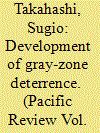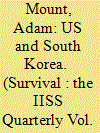| Srl | Item |
| 1 |
ID:
164486


|
|
|
|
|
| Summary/Abstract |
In contemporary international security, some powers try to challenge the status quo through gradual, sub-threshold expansion without resorting to the explicit use of force. Examples of such sub-threshold challenges can be seen in the East China Sea, the South China Sea, and Eastern Europe. They are now referred to as ‘gray zone’ or ‘hybrid threat’. For a long time deterrence theory, a core component of strategic studies, has largely neglected such sub-threshold challenges. The exceptional part of that is empirical school’s findings, including fait accompli, limited probe, and controlled pressure. They perfectly match with the current threats and help developing conceptual framework to deter these kind of threats. Based on these findings, this paper attempted to illustrate three principles for gray zone deterrence: combination of deterrence by denial and deterrence by punishment, mobilization of the whole government assets, and keeping open the window to escalation and analyze, Japan’s efforts to develop conceptual framework for gray zone deterrence. Since Japan’s efforts to develop conceptual framework of gray zone deterrence dates further back than other part of the world, as the National Defense Program Guidelines (NDPG) of 2010, a case study on Japan would provide useful insights for gray zone deterrence.
|
|
|
|
|
|
|
|
|
|
|
|
|
|
|
|
| 2 |
ID:
192145


|
|
|
|
|
| Summary/Abstract |
As US officials have grown more anxious about the credibility of extended nuclear deterrence, they have placed renewed emphasis on nuclear-assurance measures. The hope is that closer exercises and consultations can reassure allies, strengthen deterrence postures and reduce the risk that an ally could pursue their own nuclear weapons. However, recent developments in the US–South Korea alliance suggest that nuclear assurance is not only ineffective at reassuring Seoul but may also be fuelling proliferation risks. By raising the salience of nuclear weapons within the alliance, nuclear assurance reinforces the fiction that South Korea’s defence depends on nuclear use. Misunderstanding the risks and potential of nuclear assurance has fuelled calls for a South Korean nuclear-weapons programme and obstructed the alliance’s ability to adapt and improve its deterrence posture.
|
|
|
|
|
|
|
|
|
|
|
|
|
|
|
|